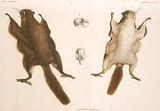
Japanese dwarf flying squirrel
Encyclopedia
The Japanese dwarf flying squirrel (Pteromys momonga; Japanese
: ニホンモモンガ; Hepburn
: Nihon momonga) is a type of flying squirrel
.
Its body is 14–20cm long and the tail length is 10–14cm. It weighs 150–220g. It is much smaller than the Japanese giant flying squirrel
which can reach 1500g. Its back is covered with grey brown hair, and its belly is white. It has large eyes and a flattened tail.
It inhabits sub-alpine forests in Japan. It is nocturnal, and during the day it rests in holes in trees. It eats seeds, fruit, tree leaves, buds and bark. It can leap from tree to tree using a gliding membrane.
Japanese language
is a language spoken by over 130 million people in Japan and in Japanese emigrant communities. It is a member of the Japonic language family, which has a number of proposed relationships with other languages, none of which has gained wide acceptance among historical linguists .Japanese is an...
: ニホンモモンガ; Hepburn
Hepburn romanization
The is named after James Curtis Hepburn, who used it to transcribe the sounds of the Japanese language into the Latin alphabet in the third edition of his Japanese–English dictionary, published in 1887. The system was originally proposed by the in 1885...
: Nihon momonga) is a type of flying squirrel
Flying squirrel
Flying squirrels, scientifically known as Pteromyini or Petauristini, are a tribe of 44 species of squirrels .- Description :...
.
Its body is 14–20cm long and the tail length is 10–14cm. It weighs 150–220g. It is much smaller than the Japanese giant flying squirrel
Japanese Giant Flying Squirrel
The is a type of flying squirrel. Like other flying squirrels it has a web of skin between its legs which it uses to glide between trees. Glides of 160 metres have been recorded. The tail is used for stability during flight. The body is about 25–50cm long, and the tail a further...
which can reach 1500g. Its back is covered with grey brown hair, and its belly is white. It has large eyes and a flattened tail.
It inhabits sub-alpine forests in Japan. It is nocturnal, and during the day it rests in holes in trees. It eats seeds, fruit, tree leaves, buds and bark. It can leap from tree to tree using a gliding membrane.

